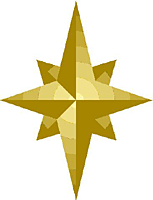AND THEY CAME BEARING GIFTS...
by Bob BrookeMay the holiday season bring peace and happiness to you and yours.
hile most people would be thrilled to discover a small box of gold beneath their Christmas tree, few would know what to do with little boxes of frankincense and myrrh. Yet two millenia ago, when the three wise men–Caspar, Melchior and Balthasar–otherwise known as the Magi, came to worship the infant Jesus, people considered gold, frankincense and myrrh all fitting and expensive offerings.
Man valued gold long before its mention in the Book of Genesis as being in the Garden of Eden (Genesis 2:11). Ancient peoples hoarded it, stole it, and created symbols from it. In antiquity, as it is today, men set gold as the economic standard, a stable value against which they could measure other commodities. But ancient Israel contained no gold. The only yellowish metal to be found there was copper from King Solomon's mines, which in ancient times people found much more useful.
Today, the pungent but pleasant scents of frankincense and myrrh are no longer popular. Though the Roman Catholic and Eastern Orthodox Churches use incense as part of a ritual dating back to pre-Christian times, people rarely use it elsewhere. But in Biblical times, people considered frankincense and myrrh, like gold, as luxuries, which they imported into the Land of Israel. Frankincense comes from the resin of a desert tree, the Boswellia Carterii, found in arid parts of Arabia, Somalia, and India. The Hebrews called it lebonah, and the prophet Isaiah records its importation: "The multitude of camels shall cover thee, the dromedaries of Midian and Ephah; all they from Sheba shall come; they shall bring gold and lebonah; and they shall show forth the praises of the Lord" (Isaiah 60:6).
Those who study word origins believe the Hebrew word lebonah comes from a root word meaning "white." Indeed, the balsamic gum is whitish when the tree secrets it. Scientists believe that people also imported the tree, from which they removed frankincense, into Israel, and cultivated it at the Judaean Desert oasis of Ein Gedi, near the Dead Sea. The Roman author Pliny the Elder wrote that people cultivated the fragrance only in the royal gardens of Judaea, but after the Roman conquest, "the tree is now a subject of Rome, and pays tribute with the race [the Jews] to whom it belongs."
The ancient Israelites associated frankincense with pure offerings to the Almighty. Several passages in Leviticus give precise details on how people should use the fragrant incense, for example:" and he shall take thereout his handful of the flour thereof, and of the oil thereof, with all the frankincense thereof, and the priests shall burn a memorial of it upon the altar, to be an offering made by fire of a sweet savour unto the Lord." (Lev. 2:2). The Bible also prescribes certain sacrificial rituals for the atonement of sins, but in these cases, it says to use frankincense is a sin: "He shall put no oil upon it, neither shall he put any frankincense thereon; for it is a sin offering" (Lev. 5:11). Thus, an offering of frankincense should only be associated with pure worship of the Almighty, and never associated with any wrongdoing. What could be a more appropriate offering for one of the three wise men to bring the infant Jesus?
Though Myrrh could be found in ancient Israel, it cost much more than other fragrances. It also comes from a tree, the Commoniphora myrrh, which is native to Arabia, Ethiopia and Somalia, but which the ancients most likely transplanted to the gardens of the Israelite kings. While the finest frankincense reportedly comes from trees which men purposely incised to tap the aromatic sap, the best myrrh comes only from the natural discharge of its trees. It slowly seeps out of the bark, first forming a thick light paste, then hardening and turning brownish red. It has a sweet smell, but a bitter taste and can be burned as an incense.
The Bible records that myrrh had been pulverized and then used as an important ingredient in holy ointments. With such a myrrh-based ointment, Moses anointed Aaron and his sons to be the priests of Israel (Ex. 30:30). Myrrh also had a more secular use, as a perfume for the wealthy: "All thy garments smell of Myrrh..." (Psalms 45:8) . Archaeological finds in Israel have revealed that the wealthy commonly wore small bags of myrrh around their necks, carrying the fragrance with them, much the same way people today wear perfumes and colognes.
The Romans also used myrrh as a spice to make the cheap wine they offered to convicts just before execution more palatable, so their deaths would be less painful. Roman soldiers offered such a drink to Jesus on Golgotha: "And they gave him to drink wine mingled with myrrh: but he received it not" (Mark 15:23).
The ancients also used myrrh as an ingredient in embalming fluids. It’s ironic that while myrrh was among the first gifts Jesus received, it was also among his last gifts. The Gospel, according to John (19:39), says Nicodemus used myrrh in the preparation of Jesus' burial: "There came Nicodemus, which at the first came to Jesus by night, and brought a mixture of myrrh and aloes, about a hundred pounds weight."
Comparing Scripture, history, archaeology and modern botany, scholars have developed some good evidence as to the origin of the three wise men. First, Matthew says they came from the east carrying gold, frankincense, and myrrh. This eliminates Somalia and Ethiopia, southern regions where these could be found. Isaiah says Midianite caravans from Sheba carried gold and frankincense, and myrrh was available in this region. Biblical Sheba has become present-day Yemen, the only eastern land with gold, frankincense and myrrh. And so, scholars agree that Yemen, the Biblical Sheba, was the home of the three wise men and the source of the first Christmas gifts which they carried on their journey to Bethlehem in the Land of Judea.
MERRY CHRISTMAS
A book makes a perfect gift for someone you care about.
Look for my new books:
The Everything Family Guide to Mexico
The Everything Family Guide to Coastal Florida
How to Recognize and Refinish Antiques
and
Shipwrecks and Buried Treasure--The Outer Banks
on sale now in your favorite bookstores and at Amazon.com.(Buy directly from Amazon.com by clicking on the book titles.)

